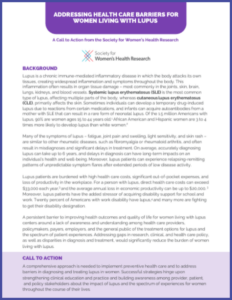 A Call to Action from the Society for Women’s Health Research
A Call to Action from the Society for Women’s Health Research
Background
Lupus is a chronic immune-mediated inflammatory disease in which the body attacks its own tissues, creating widespread inflammation and symptoms throughout the body. This inflammation often results in organ tissue damage – most commonly in the joints, skin, brain, lungs, kidneys, and blood vessels. Systemic lupus erythematosus (SLE) is the most common type of lupus, affecting multiple parts of the body, whereas cutaneous lupus erythematosus (CLE), primarily affects the skin. Sometimes individuals can develop a temporary drug-induced lupus due to reactions from certain medications, and infants can acquire autoantibodies from a mother with SLE that can result in a rare form of neonatal lupus. Of the 1.5 million Americans with lupus, 90% are women ages 15 to 44 years old.1 African American and Hispanic women are 3 to 4 times more likely to develop lupus than white women.2
Many of the symptoms of lupus – fatigue, joint pain and swelling, light sensitivity, and skin rash – are similar to other rheumatic diseases, such as fibromyalgia or rheumatoid arthritis, and often result in misdiagnoses and significant delays in treatment. On average, accurately diagnosing lupus can take up to 6 years, and delays in diagnosis can have long-term impacts on an individual’s health and well-being. Moreover, lupus patients can experience relapsing-remitting patterns of unpredictable symptom flares after extended periods of low disease activity.
Lupus patients are burdened with high health care costs, significant out-of-pocket expenses, and loss of productivity in the workplace. For a person with lupus, direct health care costs can exceed $33,000 each year,3 and the average annual loss in economic productivity can be up to $20,000.3 Moreover, lupus patients have the added stressor of acquiring disability support for school and work. Twenty percent of Americans with work disability have lupus, and many more are fighting to get their disability designation.4
A persistent barrier to improving health outcomes and quality of life for women living with lupus centers around a lack of awareness and understanding among health care providers, policymakers, payers, employers, and the general public of the treatment options for lupus and the spectrum of patient experiences. Addressing gaps in research, clinical, and health care policy, as well as disparities in diagnosis and treatment, would significantly reduce the burden of women living with lupus.
Call to Action
A comprehensive approach is needed to implement preventive health care and to address barriers in diagnosing and treating lupus in women. Successful strategies hinge upon strengthening clinical education and practice and building awareness among provider, patient, and policy stakeholders about the impact of lupus and the spectrum of experiences for women throughout the course of their lives.
The Society for Women’s Health Research (SWHR) emphasizes the following priority areas to address these persistent gaps and improve lupus care for women:
- Reduction of diagnostic delays. Women with concerns or symptoms often consult health care providers – from pediatrics and primary care to endocrinology, pulmonology, obstetrics, mental health, and other specialists – before a lupus diagnosis is determined. There is no diagnostic test for lupus, so diagnosis often relies on a process of elimination and the experience of the provider, which has the added barrier of specialist workforce shortages (including rheumatology). Thus, clinical education should also be expanded to reach a broader spectrum of providers to equip them to better recognize indications of lupus and expedite referrals to a specialist for diagnosis.
- Development of improved treatment options for lupus. The current medical and non-pharmacotherapy options largely focus on managing lupus symptoms and inflammation. Additional research investment should prioritize investigating disease etiology and progression, with a goal to develop targeted and pathway therapeutics and better options for precision medicine. Policy solutions are also needed to promote access to quality care and therapeutics, affordability, and insurance coverage with a health equity lens.
- Increased awareness about lupus and the spectrum of experiences among women. Lupus is a systemic chronic disease that requires understanding and support in clinical, policy, workplace, and social spheres. While rheumatology and nephrology are the usual health care specialties that manage lupus care, clinical education and resources should be developed and disseminated for the diverse health care professionals that are needed to provide multidisciplinary care for women with lupus. Employers and educational institutions need materials that can help them understand the unpredictability and spectrum of disease presentation, as well as address disability and workplace or school accommodations. Lastly, resources for patients and general audiences should promote supporting self-management and navigating their health care.
Immediate action to advance lupus research, education, and health care are imperative to improving women’s health. While there are several approaches that could be taken to improve health care and quality of life outcomes for women living with lupus, the steps outlined above represent significant first steps to reducing disease burden. SWHR looks forward to working with colleagues across the public health and scientific communities and federal policymakers to drive these recommendations forward to create meaningful, lasting change.
Download Call to Action
References
1. Lupus Facts and Statistics. Lupus Foundation of America. https://www.lupus.org/resources/lupus-facts-and-statistics Accessed 29 June 2022.
2. Broadway-Duren JB and Cesario SK. (2022). The Lived Experiences of Women Seeking a Diagnosis of Systemic Lupus Erythematosus. J Nurse Pract, 18(5):534-538.
3. Carter EE, Barr SG, Clarke AE. (2016). The Global Burden of SLE: Prevalence, Health Disparities and Socioeconomic Impact. Nat Rev Rheumatol, 12(10), 605-620.
4. Agarwal N, Kumar V. (2016). Burden of Lupus on Work: Issues in the Employment of Individuals with Lupus. Work, 55(2):429-439.
 A Call to Action from the Society for Women’s Health Research
A Call to Action from the Society for Women’s Health Research